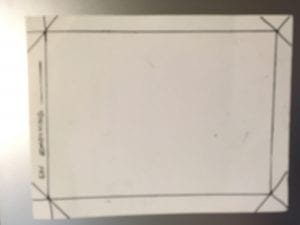Artwork#1: Writing Unknowns
Score:
-
- Obtain a small card and a black pen.
- Hand the card to someone, and Instruct them to write something you wish someone told them today. They are not allowed to say the thought aloud,
- Thank them, and hand the card to another person.
- Do not look at the card again, after this point,
- After the second person has written their note, stop instructing. Simply let the next people write what they think fits the pattern.
- Once you believe the card is sufficiently filled, rip it to pieces and dispose of them.
Artist’s Statement
The score was originally written with the idea to encompass or reflect a personal rule I held myself to, and see if it was somehow possible to translate that dogma into some sort of happening or tangible experience that someone else who isn’t me might be able to interpret it in similar fashion, or feel some similar emotion to mine. Although, the original score hadn’t quite worked out because it was perpetuated by each person who participated in the score, and involved the participants maybe divulging information they wouldn’t want to share, so the score wouldn’t get very far. In the final iteration, I decided to switch the prompt from something uncomfortably intimate to a more harmless question with an opening that allows for possibly intimate responses.

The original, empty card.

Due to the nature of the score, unfortunately there are very few documentation pictures.
Both versions of this same score were partly based off pieces such as Yoko Ono’s Cut Piece, and Painting to Hammer a Nail. Both highly involved the audience as parts of the piece, which was a strong element of what I learned in my study of happenings in 5D Fundamentals (Which I took last semester). It is the element that even in observing, one becomes part of the happening. If there is nobody to observe the events, they die off and become moot. This illustrates just how important the inclusiveness of the “consumers” is in just about any work – which is a topic that is very much personally relatable to the games industry, as I start to think about it in more technical terms. Another piece which inspired the foundations for this score, I unfortunately can’t remember the name of, but it was very simple yet powerful: It included a small piece of notebook paper, on which the author wrote several of their deepest secrets and displayed it on a museum wall, in plain view. However, the lettering on the page was so meticulously small, that though the words were in plain sight, the information was still obfuscated from just about all audiences other than the author. As mentioned, I cannot remember the piece (and neither does google, evidently), but it served as a large influence on how this score was structured, because of its heavy and personal implications to the author, as well as the obfuscation of information.
As mentioned before, the other half of the score comes from a personal place of mine: a personal rule not to say something I wouldn’t be able to say directly to the topical person, and since that was an integral part of the score, I found it would be an injustice to the point if I were to write it in a way that excludes the “holder” (The individual passing the note from person to person) from the point. This was probably the most difficult part of the score to iron out, because the split of roles from the writers to the holder almost made it seem like the score acted as two separate happenings: the cooperation from one writer to another, and the effort from to holder to remain entirely oblivious to said cooperation. Although, I found it interesting that the separation of roles could make for different interpretations of the same score, so I left it as it was. The main point of the score was to invoke thought onto someone, either from the paranoia of not knowing what was being written, or the reminiscing to find out what it is they wanted to hear today (and why).
Overall, I think the score could have been improved upon with a better prompt that somehow involved the holder with a more active role as well, though the message and original thought behind the score was still present in both iterations. More holder involvement would also make the next iteration easier to document, for sure.
